Counterfeit $50 sábanas
$50 sábanas counterfeit Type 1
The characteristics listed in Sebastián Vargas' notice of 21 March 1914 are as follows:
| GENUINE | COUNTERFEIT |
|---|---|
| letters are thicker (más gruesos) | |
| ink is blacker | |
| edging frame is made up of plates so slight breaks in corners | edging is continuous in the corners |
| Chao’s signature stroke ends in a thick flourish | Chao’s signature ends in a lump (bola o nudo) |
| Tesorería seal is rubber and handstamped so details are blurred | seal is of metal, usually steel, so details are perfect |
However, the notice was listing general characteristics for counterfeits of all denominations. These characteristics are demonstrated in Type 2 below.
$50 sábanas counterfeit Type 2
This counterfeit is based on the earliest 'Núm.' notes.
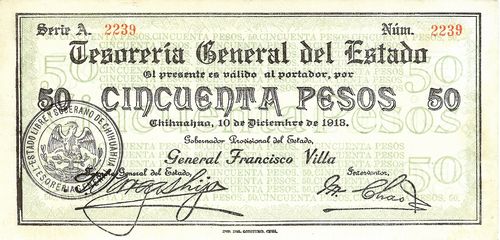
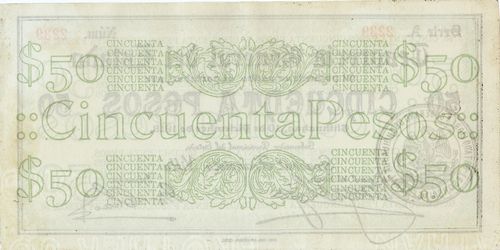
De la Garza’s letter of March 1914 and the notice of 24 March 1914 lists the following characteristics:
| GENUINE | COUNTERFEIT |
|---|---|
|
Rubber seal, somewhat smudged, with a bar before and after ‘CHIHUAHUA’ |
Steel seal, without a bar after ‘CHIHUAHUA’ |
| Seal is purple on some notes, and black on others | Purple seal |
| Small joints at the corners and various parts of edging | Edging appears continuous |
| Green type on face and reverse is thicker | |
|
|
|
|
About twenty-one fine lines in the shading of 'CINCUENTA PESOS' and '50' |
thirteen lines |
|
‘Chihuahua’ |
‘Chihnahua’ |
 ‘Diciembre’ ‘Diciembre’ |
 ‘Diciemhre’ ‘Diciemhre’ |
In the Alvarado case the characteristics listed repeat some of the above and also mention others.
| GENUINE | COUNTERFEIT |
|---|---|
| Thicker lettering | |
| Green ink of background is clearer | |
| Red 'No.' after 'SERIE A' and red 'No.' at right | No lettering at left and black 'Núm.' at right (this suggests that the early genuine 'Núm.' notes had disappeared from circulation) |
| The shading in the upper part of “50 CINCUENTA PESOS 50” is distinct, separate lines | Shading is formed by thinner lines, that are oftren joined |
| Design is 189mm by 88½mm | |
| Chao’s signature has an inkspot at the far right flourish (el vértice superior y derecho de la firma hay un burrón en forma de punto) | No inkspot |
 Comma after 'válido' Comma after 'válido' |
 No comma after 'válido' No comma after 'válido' |
| Occasional breaks in the edging, particularly in the corners | Edging is blacker, thicker and formed by a single line |
|
Seal is rubber and applied by hand, so details of the eagle and lettering are blurred |
Seal is metal and imprinted, so details are equal and distinct No bar after 'GENERAL' |
This type is known as in production before the serial numbers were added
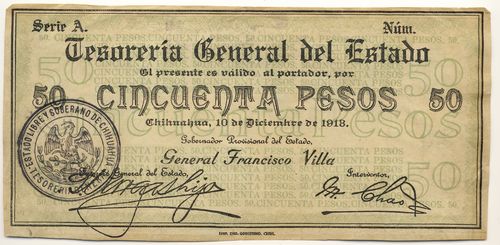
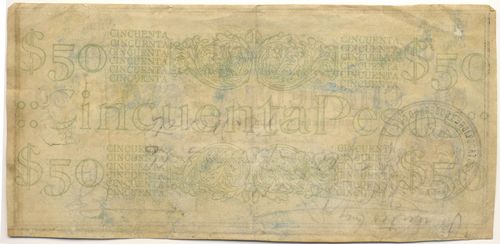
and also when stamped as counterfeit.
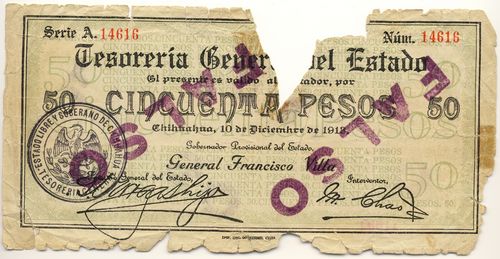
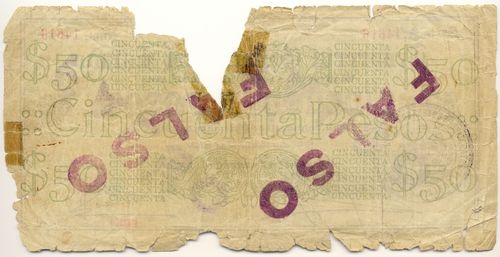
The "Diciemhre' misspelling might have been due to copying a similar misspelling on early genuine notes. So the December 1914 notice rightly informs us that if Vargas and Chao’s are handsigned, the notes with ‘Diciemhre’ are genuine.
$50 sábanas counterfeit Type 3
The notice issued by the Tesorería General in Hermosillo, Sonora lists:
| GENUINE | COUNTERFEIT |
|---|---|
|
first two ‘h’s the same whilst third is different |
three ‘h’s of Chihuahua the same |
|
full stop of the phrase ‘Chihuahua, 10 de Diciembre de 1913’ is diamond shaped |
full stop is round |
|
comma after ‘Gobernador Provisional del Estado’ |
full stop after ‘Gobernador Provisional del Estado’ |
| full stop in the ‘M’ of Chao’s signature missing |
However, notes with three similar 'h's are common and known with a variety of resellos, and so this notice does not inspire confidence and will have caused a lot of confusion. The reference to a full stop on Chao's signature might also be confused as another counterfeit is identifiable through Chao's signature, thus.
$50 sábanas counterfeit Type 3a
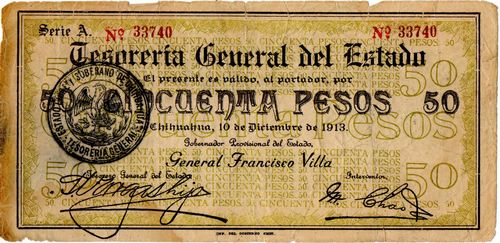
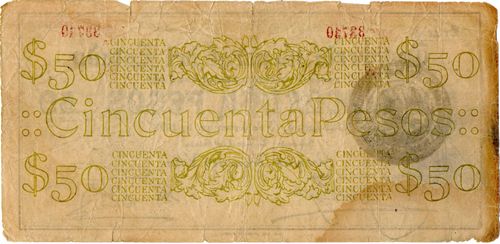
| GENUINE | COUNTERFEIT |
|---|---|
|
full stop of the phrase ‘Chihuahua, 10 de Diciembre de 1913’ is diamond shaped |
full stop is round |
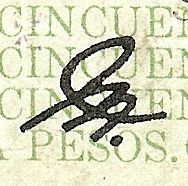 |
spot in the upper loop of 'M' in Chao’s signature |
$50 sábanas counterfeit Type 4
In May 1915 a large quantity of counterfeit $50 "Constitutionalist" notes were circulating in Tampico, Tamaulipas. The authorities arrested four Americans, Jim Sigler, the owner of a nearby ranch, and S. Thomson and his two sons. They confessed to having bought $500,000 in fake notes from an American but had only put $20,000 into circulation. The notes were very coarse and also had a fake REVALIDADO seal. The Jefe de las Armas, Coronel Espinosa, had a conference with the American consul and they agreed that the counterfeiters would be deported, after they guaranteed to make good any loss that the public had sufferedEl Democráta, Veracruz, Tomo I, Num. 199, 27 May 1915. However, the New York Times a month later reported that three Americans, William Thompson, his brother, Robert, and a man named Segler, had recently been brought to Veracruz from Tampico charged with circulating counterfeit money. William Thompson had been released, according to reports received by Secretary Lansing, and his brother Robert would be. The charge against Segler appeared to be more serious, and his case was pendingNew York Times, 27 June 1915.
In August it was reported that four American residents of Tampico had been sentenced to long penitentiary terms for counterfeiting. It was reported that the Americans had been placed on board the Mexican gunboat Bravo and sent to VeracruzFort Worth Star-Telegram, 11 August 1915.
These appear to have been $50 sábanas and though described as "very coarse" the fake REVALIDADO suggest this probable counterfeit..
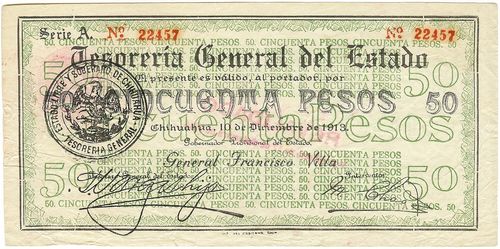
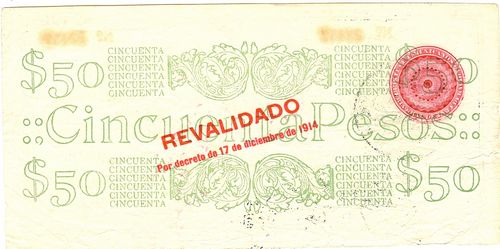
| GENUINE | COUNTERFEIT |
|---|---|
|
'A' in 'Serie A' open |
'A' closed |
|
|
|
|
full stop after 'PESOS' in centre of last line of underprint |
no full stop |

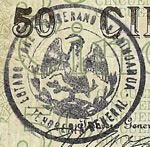
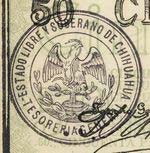
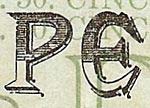
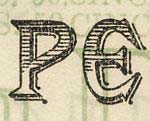







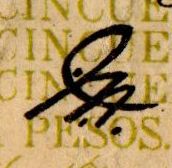

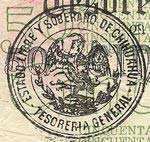 seal 41.5mm
seal 41.5mm
